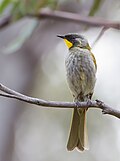Superregnum: Eukaryota
Cladus: Unikonta
Cladus: Opisthokonta
Cladus: Holozoa
Regnum: Animalia
Subregnum: Eumetazoa
Cladus: Bilateria
Cladus: Nephrozoa
Superphylum: Deuterostomia
Phylum: Chordata
Subphylum: Vertebrata
Infraphylum: Gnathostomata
Megaclassis: Osteichthyes
Cladus: Sarcopterygii
Cladus: Rhipidistia
Cladus: Tetrapodomorpha
Cladus: Eotetrapodiformes
Cladus: Elpistostegalia
Superclassis: Tetrapoda
Cladus: Reptiliomorpha
Cladus: Amniota
Classis: Reptilia
Cladus: Eureptilia
Cladus: Romeriida
Subclassis: Diapsida
Cladus: Sauria
Infraclassis: Archosauromorpha
Cladus: Crurotarsi
Divisio: Archosauria
Cladus: Avemetatarsalia
Cladus: Ornithodira
Subtaxon: Dinosauromorpha
Cladus: Dinosauriformes
Cladus: Dracohors
Cladus: Dinosauria
Cladus: Saurischia
Cladus: Eusaurischia
Subordo: Theropoda
Cladus: Neotheropoda
Cladus: Averostra
Cladus: Tetanurae
Cladus: Avetheropoda
Cladus: Coelurosauria
Cladus: Tyrannoraptora
Cladus: Maniraptoromorpha
Cladus: Maniraptoriformes
Cladus: Maniraptora
Cladus: Pennaraptora
Cladus: Paraves
Cladus: Eumaniraptora
Cladus: Avialae
Infraclassis: Aves
Cladus: Avebrevicauda
Cladus: Pygostylia
Cladus: Ornithothoraces
Cladus: Ornithuromorpha
Cladus: Carinatae
Parvclassis: Neornithes
Cohors: Neognathae
Cladus: Neoaves
Cladus: Telluraves
Cladus: Australaves
Ordo: Passeriformes
Subordo: Passeri
Infraordo: Corvida
Superfamilia: Meliphagoidea
Familia: Meliphagidae
Genus: Nesoptilotis
Species: N. flavicollis – N. leucotis
Name
Nesoptilotis Mathews, 1913
Typus: Ptilotis flavigula Gould, 1838 syn. Melithreptus flavicollis Vieillot, 1817 = Nesoptilotis flavicollis
References
Primary references
Mathews, G.M. 1913. New generic names, with some note on others. The Austral Avian Record; a scientific journal devoted primarily to the study of the Australian avifauna 2(2&3): 55–62 BHL Reference page. p. 60
Additional references
Nyári, A.S. & Joseph, L. 2011. Systematic dismantlement of Lichenostomus improves the basis for understanding relationships within the honeyeaters (Meliphagidae) and the historical development of Australo-Papuan communities. Emu 111: 202–211. DOI: 10.1071/MU10047 ResearchGate Reference page.
Nesoptilotis is a genus of honeyeaters endemic to Australia and Tasmania. The genus consists of two former members of Lichenostomus, and was created after a molecular phylogenetic analysis published in 2011 showed that the original genus was polyphyletic.[2]
The genus contains two species:[3]
| Image | Scientific name | Common Name | Distribution |
|---|---|---|---|
 |
N. flavicollis | Yellow-throated honeyeater | Tasmania |
 |
N. leucotis | White-eared honeyeater | southwest, south and east Australia |
The name Nesoptilotis was first proposed by the Australian ornithologist Gregory Mathews in 1913.[4][5] The word is derived from the Greek nēsos island (i.e. Tasmania), ptilon feather and -ōtis eared.[6]
References
"Melaphagidae". aviansystematics.org. The Trust for Avian Systematics. Retrieved 2023-07-16.
Nyári, Á.S.; Joseph, L. (2011). "Systematic dismantlement of Lichenostomus improves the basis for understanding relationships within the honeyeaters (Meliphagidae) and historical development of Australo–Papuan bird communities". Emu. 111 (3): 202–211. doi:10.1071/mu10047.
Gill, Frank; Donsker, David (eds.). "Honeyeaters". World Bird List Version 6.1. International Ornithologists' Union. Retrieved 28 January 2016.
Mathews, Gregory M. (1913). "New generic names with some notes on others". Austral Avian Record. 2: 55–62 [60].
Salomonsen, F. (1967). "Family Maliphagidae, Honeyeaters". In Paynter, R.A. Jnr. (ed.). Check-list of birds of the world (Volume 12). Cambridge, Mass.: Museum of Comparative Zoology. p. 365.
Jobling, James A. (2010). The Helm Dictionary of Scientific Bird Names. London: Christopher Helm. pp. 269, 321. ISBN 978-1-4081-2501-4.
Retrieved from "http://en.wikipedia.org/"
All text is available under the terms of the GNU Free Documentation License

